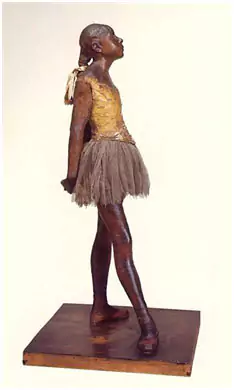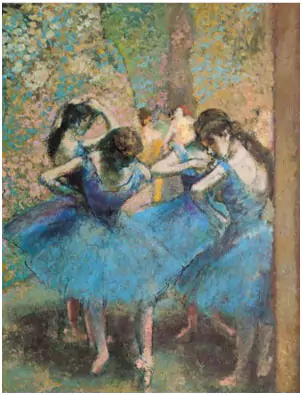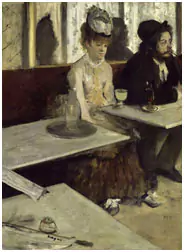Biography
Edgar Degas (French 1834-1917) was born Edgar Hilaire Germaine De Gas. He was a founding member of the Impressionist movement and a forefather of Modernism in Western art. Degas became famous and is best known for his portrayals of ballerinas. He was a pioneer in using many compositional innovations and in the portrayal of modern, urban subject matter. But Degas never betrayed his devotion to the working methods of the Old Masters. Degas' experimentations with emerging media like synthetic pigments, photography, lithography and pastel were groundbreaking and helped to pave the way for the work of Pablo Picasso, Amedeo Modigliani and Paul Gauguin.

Degas, Portrait of the Artist, 1855, oil on paper mounted on canvas, 81.5 x 65 cm, Museé d'Orsay
Formative Years
Degas was born to an upper middle class family in Paris. His mother Celestine was from a Creole family. His father Auguste from a family of Italian bankers with some noble ties. The eldest child of five it was thought Degas would study law and take over the family business. Yet his father shared with Degas a passion for art and music. He often took young Edgar to visit notable art collectors of the day. The private collections of friends and art auctions were other frequent family outings for the Degas men. Celestine, Degas' mother died when he was only thirteen. The young Degas attended law school to please his father, but spent his spare moments copying masterworks at the Louvre. As a teenager, Degas converted his room into an art studio. Degas' father eventually relented and enrolled his eldest at the École des Beaux Arts. Degas attended for a semester before departing on his own privately funded Grand Tour. This entailed artistic studies in several parts of Italy, where Degas stayed with his family. He painted copies of masterpieces, portraits of himself and his family members.

Edgar Degas, A Roman Beggar Woman, 1857, oil on canvas, 100.3 x 75.2 cm Birmingham Museum and Art Gallery, Birmingham, UK

Edgar Degas, Young Spartans Exercising, c. 1860, oil on canvas, 109.5 x 155 cm, The National Gallery, UK
Determined to become a history painter (the most preeminent role for artists of the time) Edgar setup a studio in Paris and began producing works for the Salon. He first exhibited at the Salon in 1865. He found it challenging to get his work noticed on the busy walls of the annual Académie de Peinture et Sculpture exhibitions, so Degas wrote to the organizers imploring them to reconsider their display methods. Degas also found it difficult to finish his work, compulsively reworking details and entire canvases again and again. This was his pattern for the rest of his life. Collectors liked to joke they should chain their Degas' to the wall, to prevent him from taking them back into his studio.
Degas' father was overjoyed with his son's first truly finished painting, The Orchestra at the Opera. The painting was a portrait of his friend the bassoonist Désiré Dihau. It also included Degas' first depiction of ballerinas. This painting was spared the artist's endless retouching by a temporary shipping embargo following exhibition.

Edgar Degas, Family portrait (The Bellilli Family), 1858-1869, oil on canvas, 201x 249.5 cm, Musée d'Orsay

Edgar Degas, The Orchestra at the Opera, c. 1870, oil on canvas, 45 x 56 cm, Musée d'Orsay
Subject Matter
Degas gained public acclaim by the 1880s. He was famous first for his racetrack scenes, then for his scenes of ballerinas. Degas became a regular fixture at the Paris Opera, attending rehearsals and lessons to execute studies. His portrayals were unusual and complex, hinting at a great enigma within the subject matter. Degas often depicted the decaying power dynamics of the ballet, where impoverished young women (and children) were accepted into the ballet corps under the questionably-intentioned patronage of wealthy older men. Degas, always unsparing in his portrayals, occasionally shows us the shadowy legs of these patrons waiting in the wings in ballet rehearsals. Degas' paintings also showed the intense physical rigors and exhaustion of the ballerinas in training.

Edgar Degas, The Rehearsal of the Ballet Onstage, c. 1874, Metropolitan Museum of Art
Degas also gained recognition for his urban subject matter and the complexity of images of lower class denizens of Paris: cafe concert singers, circus performers, laundresses, prostitutes and women at the bath (nudes). At the end of his career Degas ventured into painting landscapes. This was in open competition with Monet and Cézanne, who were famous for their landscapes. Degas also painted many portraits throughout his career. He painted the portraits only of friends and family; he never accepting commissions.
Methods
Degas frequently sketched live models over and over again famously declaring "no art is less spontaneous than mine." He said, "for a portrait [an artist should] have your model pose on the first floor and work upstairs to accustom yourself to retaining forms and expressions." Degas felt an artist should know his subject profoundly enough that he could work solely from memory. Degas was in the vanguard of portraying bodies in motion. In the 1870s, Degas was fascinated by Muybridge's photo series of racehorses. In response, Degas began creating portrayals of horses in motion. Degas was keen on capturing the in-between moments in motion, the natural pauses or momentary gestures, where he felt some greater truth of human nature was revealed.

Edgar Degas, Racehorses at Longchamp, 1871-1874, oil on canvas, 34 x 41.9 cm, Museum of Fine Arts, Boston

Edgar Degas, Singer with a Glove, c. 1878, pastel on paper mounted on canvas, 53.2 x 41 cm, Fogg Art Museum
Degas experimented with photography as well as new media in sculpture and printing. In the second half of his career, Degas became a master of the monotype. These were single prints of ink or paint on a plate that he then worked on top of with pencil or essence. In sculpture he experimented with unconventional materials, creating his famous Little Dancer with wood, sawdust, wire, batting and wax. Degas then dressed Little Dancer in real tulle, velvet ribbon and human hair. The exhibition of Little Dancerat the 1881 Impressionist Exhibition caused a stir among critics and viewers shocked by Degas' realism.

Edgar Degas, Little Dancer (Fourteen Years Old), 1879-1881, Wax and bronze reproduction, 48" high, National Gallery of Art, USA

Edgar Degas, Blue Dancers, 1893-1896, Oil on canvas, 85.3 x 75.3 cm, Musée d'Orsay
Influences & Impressionism
Degas, like many of the Impressionists, was fond of such new techniques as cropped compositions, dramatic outlines, color theory, and loose brushstrokes. Like many others of his time, he was enchanted by Japanese prints. Degas always called himself a Realist rather than an Impressionist. Degas criticized the "licked" look of thick oil paint, the garish colors and the slapdash methods of en plein air painting. He had sometimes contentious relations with his colleagues. Many considered Degas the most respectable artist of his time because he was born into a Haute Bourgeois family, and never completely abandoned the principles of academic draftsmanship in his art.
Personal Life
Degas' career was interrupted for several years by the Franco-Prussian war in 1870. He enlisted to serve in the military. But in 1871, Degas moved to Normandy. He was not affected by the Paris Commune. Shortly after this, Degas visited his family in New Orleans, where they were involved in the cotton trade. At about this time, Degas began to notice his eyesight deteriorating He suffered from a scotoma which occasionally obscured his central vision, caused a sensitivity to bright daylight, and produced color distortion. By the 1880s, his vision became more seriously impaired. It progressed to almost total blindness by the early 1910s. Degas worked as long as he could shifting to more tactile mediums like sculpture and pastel in his later life.

Edgar Degas, In a Cafe [L'absinthe] 1875-1876, oil on canvas, 92 cm × 68 cm (36.2 in × 26.8 in), Musée D'Orsay

Edgar Degas, A Cotton Office in New Orleans, 1873, oil on canvas 73 x 92 cm,, Musée des Beaux-Arts de Pau, Pau, France
Poor financial decisions by his family left Degas in dire financial straits in the mid 1870s. Degas was forced to make a living from his art for the first time when after his father's death he found his family was in debt. Degas' brother abandoned a disabled wife and his children. Another brother of Degas shot a former mistress's husband and was jailed. Degas supported both of his brothers by churning out popular works, and he even painted fans. He spent many years slowly paying off his family's debts.
In 1870, Edgar De Gas officially changed his surname to Degas.
Character
Throughout his life Degas was known for his insightful yet cutting wit, and somewhat morose nature. He never married nor was known to have romantic affairs. Degas did develop a close relationship with the American artist Mary Cassatt. This association proved mutually beneficial. Degas assisted Cassatt in developing her art. Cassatt helped to introduce Degas' artwork to the American market. Degas' anti-Semitic views expressed during the late nineteenth-century Dreyfus Affair made him unpopular with many of his colleagues.

Edgar Degas, Danseuses á la barre (Dancers at the Barre), 1877, oil on canvas, 75.6 x 81.3 cm, Metropolitan Museum of Art
Legacy
Degas reached international success in his own lifetime when his painting Danseuses a la barre sold for half a million francs at Durand-Ruel in 1912. But his blindness became disabling that year and he stopped painting. When he died in 1917, Degas was acclaimed as a French national treasure. After Degas' death, followers were shocked to find over a thousand previously unknown original paintings, pastels, prints and drawings. More than half of them were of dancers. Degas also acquired a massive collection of Old Master and modern artists, some 5,000 prints and 500 paintings by artists like El Greco, Ingres, Daumier, and Manet. His estate was distributed in a series of sales over several years.